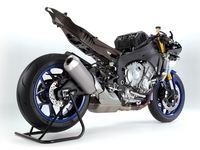ENGINE
Besides the inline-four layout and uneven, 270-180-90-180-degree firing order, the Yamaha 998cc "CP4" engine has nothing in common with the previous Crossplane mill. Engine geometry is now more oversquare—bore and stroke is 79.0 x 50.9mm—and relocating the primary balancing weights has reduced the crank's inertial moment by 20 percent, Yamaha says, for stronger acceleration and livelier engine character. Fracture-split titanium connecting rods—a production-bike first, Yamaha says—are said to be 40 percent lighter than steel, and forged aluminum, box-type pistons are lighter despite being larger. Compression is raised slightly to 13.0:1 (from 12.7), and the cylinder head has been completely reconfigured with larger intake and exhaust valves (33mm and 26.5mm, respectively, the former now made from titanium) arranged at a narrower angle to improve combustion-chamber shape. Rocker arms directly between the cams and valve buckets—not overhung—now lift the valves higher and quicker while decreasing cam loads at the same time to reduce friction losses. The fuel-injection system is also new, with 12-hole main injectors backed up with secondary showerheads that operate at higher rpm. A new airbox is 2 liters larger than before, feeding 45mm throttle bodies equipped with Yamaha Chip-Controlled Intake (YCC-I) variable-length intake stacks. Nearly all the engine bolts are aluminum and the oil pan and engine covers are crafted from magnesium, making the new engine 9 pounds lighter than the old one—1.2 inches narrower too. A new grip-and-slip clutch transfers power to the chain final drive, and an electronic quickshifter is standard equipment too.
ELECTRONICS
A hailstorm of acronyms describes the many "rider adaptive technologies" that distinguish the new YZF-R1 . Start with IMU, shorthand for the six-axis Inertial Measurement Unit that combines three gyro sensors—one each to monitor pitch, yaw, and roll—and three G sensors—measuring up-down, right-left, and fore-aft accelerations—to provide a 3-D picture of vehicle dynamics at all times. This IMU enables multiple Yamaha Ride Control (YRC) systems, including traction control, race ABS, launch control, wheelie control, and, for the first time ever on a production bike Yamaha says, rear-wheel slide control designed to arrest lateral tire slides that occur independent of wheelspin—technology that has only existed on the YZR-M1 MotoGP bike since 2012. The IMU analyzes incoming data 125 times per second and sends directions to the ECU, where torque is cut one of three ways: altering throttle angle, fueling, or ignition. YRC offers four global presets for one-click selection of all rider controls; each separate system can be further adjusted independently—nine levels of TC intervention, for example, or three levels of front wheel lift abatement—or they can be deactivated completely (all except for ABS). Four separate power modes further tailor throttle response and power delivery.
The YZF-R1 offers full datalogging capability as well. A GPS-enabled Communication Control Unit (CCU) datalogger (optional on the base-model; standard on the R1M) records lap times, engine rpm, throttle position, brake pressure, and much, much more then sends this data via Wi-Fi to a smartphone or tablet equipped with the Yamaha Telemetry Recording and Analysis app. GPS connectivity lets you analyze this data overlaid with a track or course map; you can also use the same app functionality to remotely adjust the many YRC settings.
CHASSIS
An all-new, now-asymmetric Deltabox frame, welded together from gravity-cast pieces, has been rigorously redesigned to be lighter and more compact than the previous rack. The 55.3-inch wheelbase is a half-inch shorter than before, but the swingarm-to-wheelbase ratio and rake and trail are unchanged. The rigid-mounted engine acts as a fully stressed member, and the truss-type swingarm, constructed from a mix of gravity-cast and forged pieces, is polished on the more-expensive R1M edition. The subframe on both bikes is made from weight-saving magnesium, as are new 10-spoke wheels that save a significant 2 pounds of unsprung mass.
SUSPENSION
The base R1 uses the latest fully adjustable suspension components from KYB, consisting of a 43mm fork up front and a linkage-mounted monoshock out back. The R1M gets a major hardware upgrade in the form of Öhlins ' latest Electronic Racing Suspension (ERS), which harvests dynamic feedback from the bike's IMU and communicates with a Suspension Control Unit (SCU) that directs small stepper motors on the shock and fork legs to automatically fine-tune compression and rebound damping in response to real-time riding conditions. The ERS system offers three automatic damping schemes, along with three manual modes that disable the real-time auto-adjusting functionality. Damping can be further fine-tuned within these presets to fit any rider's individual preferences, with 18 discrete levels of compression and 22 levels of rebound damping available.
BRAKES
Four-piston monoblock calipers and 320mm rotors connected with stainless-steel lines provide braking force; race-spec ABS provides braking finesse. Unified braking activates the single-piston rear caliper/220mm disc combination whenever the front brake is applied to decrease unwanted chassis movement and increase stability on corner entries. Brake force distribution is adjusted according to chassis attitude and lean angle, based on information sent from the IMU, changing brake power and distribution as much as 125 times per second. Unlike traction control and other rider aids, ABS is not switchable—in other words, you cannot turn it off, unless the bike is fitted with the accessory race-kit ECU.
















/cloudfront-us-east-1.images.arcpublishing.com/octane/QSTCM6AVEZA5JJBUXNIQ3DSOF4.jpg)
/cloudfront-us-east-1.images.arcpublishing.com/octane/U4I7G625B5DMLF2DVIJDFZVV6M.jpg)
/cloudfront-us-east-1.images.arcpublishing.com/octane/B6XD6LS6IVCQPIU6HXDJSM3FHY.jpg)
/cloudfront-us-east-1.images.arcpublishing.com/octane/ICL63FEDDRDTTMINYICCEYGMDA.jpg)
/cloudfront-us-east-1.images.arcpublishing.com/octane/FCGZHQXRBZFLBAPC5SDIQLVF4I.jpg)
/cloudfront-us-east-1.images.arcpublishing.com/octane/WNOB6LDOIFFHJKPSVIWDYUGOPM.jpg)

/cloudfront-us-east-1.images.arcpublishing.com/octane/X33NU3E525ECRHXLNUJN2FTRKI.jpg)
/cloudfront-us-east-1.images.arcpublishing.com/octane/6KKT5NNL2JAVBOXMZYS5ZO76YA.jpg)
/cloudfront-us-east-1.images.arcpublishing.com/octane/J5RKG5O455GMPGQRF2OG6LRT7A.jpg)
/cloudfront-us-east-1.images.arcpublishing.com/octane/GX2CIZKQVRH2TATDM26KFG2DAE.jpg)
/cloudfront-us-east-1.images.arcpublishing.com/octane/ZWIDYSAKQZHD5BHREMQILXJCGM.jpg)
/cloudfront-us-east-1.images.arcpublishing.com/octane/CYUHJZCTSJCH3MRAQEIKXK7SCQ.jpg)
/cloudfront-us-east-1.images.arcpublishing.com/octane/LKOFINY56FCXJCANJ5M7ZDQUBY.jpg)
/cloudfront-us-east-1.images.arcpublishing.com/octane/4NBPDACMWJH63JQYJVK3QRBDZI.jpg)
/cloudfront-us-east-1.images.arcpublishing.com/octane/KKHQHRR3FJGX7H2IPU6RALMWG4.jpg)

/cloudfront-us-east-1.images.arcpublishing.com/octane/5IOFS5JAE5FOXMNA23ZRAVVYUU.jpg)
/cloudfront-us-east-1.images.arcpublishing.com/octane/CGXQ3O2VVJF7PGTYR3QICTLDLM.jpg)

/cloudfront-us-east-1.images.arcpublishing.com/octane/OQVCJOABCFC5NBEF2KIGRCV3XA.jpg)
/cloudfront-us-east-1.images.arcpublishing.com/octane/OPVQ7R4EFNCLRDPSQT4FBZCS2A.jpg)
/cloudfront-us-east-1.images.arcpublishing.com/octane/YBPFZBTAS5FJJBKOWC57QGEFDM.jpg)
/cloudfront-us-east-1.images.arcpublishing.com/octane/W5DVCJVUQVHZTN2DNYLI2UYW5U.jpg)